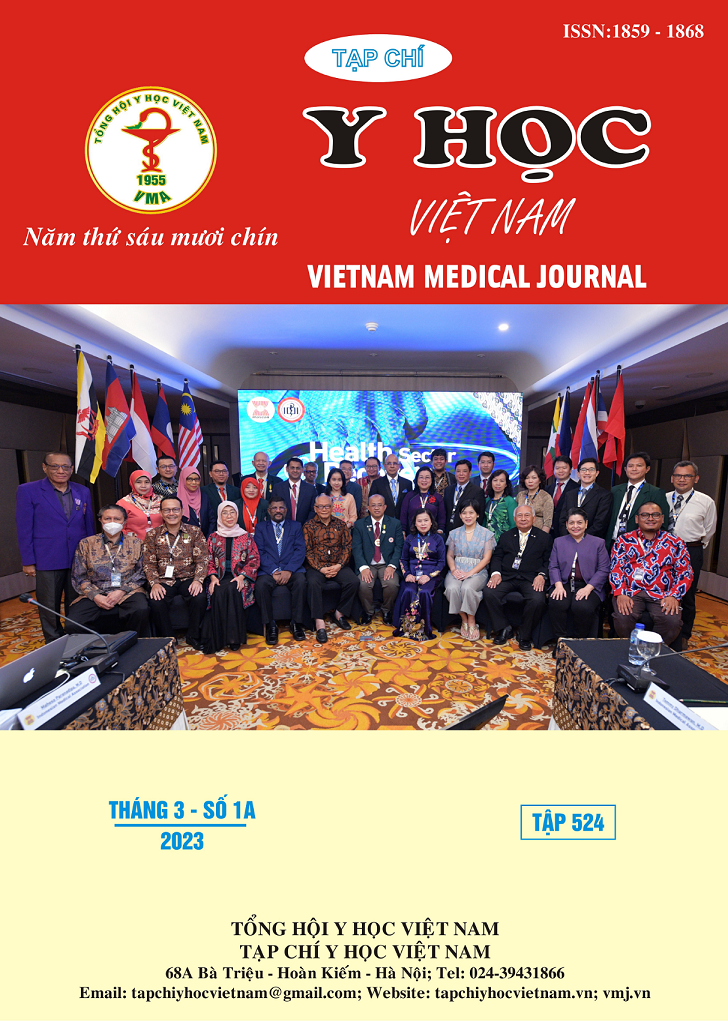REFRACTIVE RESIDUALS AFTER PHACO SURGERY WITH PANOPTIX INTRAOCULAR LENSES
Main Article Content
Abstract
Objectives: Evaluation of Refractive residuals after phaco surgery with Panoptix intraocular lenses. Subjects and methods: Prospective corelation study, Thirty-five eyes of the patient had only indications for Phaco surgery to place Pannoptix Intraocular lens and agreed to participate in the study, at Nghe An Eye Hospital from July 2021 to July 2022. Results: At 3 months after surgery, 19.4% of eyes had a vision loss of more than 3 lines between high contrast and low contrast, the remaining 80.6% of eyes had a vision difference of 3 lines or less. The difference was statistically significant with p < 0.001. Residual spherical refraction after surgery was within ± 0.5 D with 94.4% at 1 week after surgery, this ratio continued to increase at 1 month and stabilized at 3 months later. surgery (97.2%). After 1 week of surgery, 58.3% had corneal astigmatism less than or equal to 0.5 D, the remaining 41.7% had corneal astigmatism of 0.75 D or more. Up to 1 month after surgery, the rate of astigmatism 0.5 D increased while the rate of astigmatism 0.75 D decreased. At all times, there was no case of corneal astigmatism ≥ 1.75 D. Bridge power and bridge equivalent power at 1 week, 1 month and 3 months after surgery had significant changes. statistical with p < 0.05. Cylindrical capacity at 1 week after surgery compared with 1 month and 3 months after surgery also had a significant difference with p < 0.001; and at 1 month and 3 months after surgery, the change in cylinder capacity was not statistically significant with p > 0.05. At 3 months after surgery, postoperative corneal astigmatism had an effect on uncorrected distal vision, intermediate visual acuity and uncorrected near vision at a statistically significant level with p < 0, 05 and affect the distance vision and near vision after maximal glasses correction at the level of no statistical significance with p > 0.05
Article Details
Keywords
Trifocal, Panoptix, Intraocular Lens, Refractive residuals
References
2. Park CY, Chuck RS (2011). Residual refractive error and visual outcome after cataract surgery using spherical versus Aspheric IOLs. Ophthalmic Surg Laser Imaging, 42(1), 37-43.
3. Levitz L, Reich J, Roberts K et al (2015). Evaluation of Toric Intraocular Lenses in Patients With Low Degrees of Astigmatism. Asia Pac J Ophthalmol (Phila), 4(5), 245-9.
4. Visser N, Nuijts RM, de Vries NE et al (2011). Visual outcomes and patient satisfaction after cataract surgery with toric multifocal intraocular lens implantation. J Cataract Refract Surg, 37(11), 2034-42.
5. Gangwani V, Hirnschall N, Findl O et al (2014). Multifocal toric intraocular lenses versus multifocal intraocular lenses combined with peripheral corneal relaxing incisions to correct moderate astigmatism. J Cataract Refract Surg, 40(10), 1625-32.
6. Kretz FT, Bastelica A, Carreras H et al (2015). Clinical outcomes and surgeon assessment after implantation of a new diffractive multifocal toric intraocular lens. Br J Ophthalmol, 99(3), 405-11.
7. Musanovic Z, Jusufovic V, Halibasica M et al (2012). Corneal astigmatism after micro-incision cataract operation. Med Arh, 66(2), 125-8.
8. Wang J, Zhang EK, Fan WY et al (2009). The effect of micro-incision and small-incision coaxial phaco-emulsification on corneal astigmatism. Clin Experiment Ophthalmol, 37(7), 664-9.
9. De Vries NE, Webers CA, Touwslager WR et al (2011). Dissatisfaction after implantation of multifocal intraocular lenses, JCataract Refract Surg, 37(5), 859-65.
10. Hayashi K, Manabe S, Yoshida M et al (2010). Effect of astigmatism on visual acuity in eyes with a diffractive multifocal intraocular lens. JCataract Refract Surg, 36(8), 1323-9.


